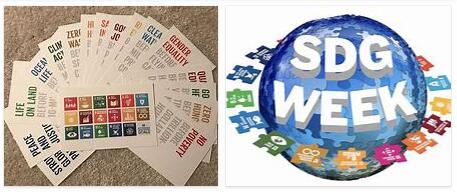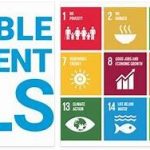5: Not just developing countries
In order to be able to measure progress in implementation, the goals have been broken down into several sub-goals. Where the eight millennium goals consisted of 21 sub-goals, the 17 sustainability goals focus on as many as 169. Critics claim that it is a great challenge that the goals and sub-goals are too many, complex and at times contradictory. This, they believe, can contribute to undermining the implementation itself. Several critics have also argued that the sustainability goals are more a result of different authorities and interest groups lobbying for their interests and values, than that the goals are a result of the needs of those to whom the SDGs actually apply.
Others, however, believe it is positive and that there are opportunities in that the sustainability goals are more comprehensive and ambitious than the millennium goals, by now also addressing urbanization , infrastructure and climate change – themes that are not limited to the global South, as was the case with the Millennium Development Goals. While the Millennium Development Goals were mainly linked to development policy and countries in the South, the sustainability goals require change and action here at home as well. For example, there is a focus on climate and environment, biodiversity related to life on land and under water, clean energy and responsible consumption and production. This means that western actors will no longer only finance activities abroad, in traditional developing countries. The sustainability goals are universal, so already developed countries must take action and make the necessary adjustments that are also needed at home.
In a Norwegian context, this means that the sustainability goals are not only relevant and leading for foreign and development policy. Other policy areas, and especially those with an international orientation such as oil and energy, climate and environment, industry and trade, are also central. The challenge is to create coherence between the policy areas, but also to balance national self-interests with global common interests where these should come into conflict with each other. Coordinated policy is not only a challenge internally in Norway, but also internally in most other countries – which makes coherent policy between countries even more challenging.
Despite great agreement that this is both correct and important, it is also a source of concern. It has traditionally been easier for Western countries to finance and help other countries make changes than to change their own policies. The question thus becomes whether Western and especially newly industrialized middle-income countries are inclined to meet the requirements of the sustainability goals and the constraints on which they are based to achieve sustainable development.
6: A global sustainable development
It is naturally the concept of “sustainable development” that forms the basis for the sustainability goals. This concept was first launched in the report “Our common future” from 1987 , presented by the World Commission on Environment and Development. The commission is also called the Brundtland Commission, since it was chaired by Gro Harlem Brundtland. According to the report, sustainable development is a development that satisfies today’s needs without destroying future generations’ opportunities to meet their needs. The sustainability goals require that all economic, social and environmental development must be sustainable.
While the first 16 sustainability goals deal with different policy areas, the last and 17th goal are about how the previous goals can be realized by reviving a global partnership for sustainable development. To achieve the ambitious goals, such a partnership is based on comprehensive and coordinated cooperation between government actors, civil society, the private sector, the UN system and other relevant actors. Despite the fact that coordination between actors with different interests and mandates is difficult, the SDGs have so far had a mobilizing effect on both cooperation and financing.
It is too early to say anything about the results, the general effect or the implementation of the sustainability goals. The ambitions are great, and the fall height corresponding. But even if it turns out to be difficult to achieve all the goals everywhere, hopefully the vision of eradicating poverty and hunger will benefit those who need it most. To ensure and monitor progress, the UN Secretary-General provides a comprehensive status report annually based on the latest available data. Here, both achieved results and challenges are highlighted to ensure that global efforts are continuously adjusted by 2030.
7: Are we able to reach the goals?
According to polyhobbies, there was great international skepticism about the Millennium Development Goals when they were launched, but when the finish line was set in 2015, the result was surprisingly positive for many countries. A similar skepticism is noticed today associated with the sustainability goals, but one must allow oneself to hope that today’s critics will be guilty in the years to come, just as yesterday’s critics were in 2015. However, there are potential challenges. The authorities responsible for implementing the sustainability goals may perceive them as too diverse, comprehensive, fragmented and at times contradictory. But the sustainability goals have undeniably had a mobilizing effect and brought together a diversity of actors around a common, global project – and the decision on whether we have succeeded will not be achieved until 2030.
Facts
These are the sustainability goals:
Goal 1. Eradicate all forms of poverty worldwide
Goal 2. Eradicate hunger, achieve food security and better nutrition, and promote sustainable agriculture
Goal 3. Ensure good health and promote quality of life for everyone, regardless of age
Objective 4. Ensure inclusive, fair and good education and promote opportunities for lifelong learning for all
Goal 5. Achieve equality and strengthen the position of girls and women
Objective 6. Ensure sustainable water management and access to water and good sanitation for all
Goal 7. Ensure access to reliable, sustainable and modern energy at an affordable price
Goal 8. Promote lasting, inclusive and sustainable economic growth, full employment and decent work for all
Goal 9. Build robust infrastructure, promote inclusive and sustainable industrialization and contribute to innovation
Goal 10. Reduce inequality in and between countries
Goal 11. Make cities and settlements inclusive, safe, resilient and sustainable
Goal 12. Ensure sustainable consumption and production patterns
Goal 13. Take immediate action to combat climate change and its consequences *
Objective 14. Conserve and use marine and marine resources in a way that promotes sustainable development
Objective 15. Protect, restore and promote sustainable use of ecosystems, ensure sustainable forest management, combat desertification, halt and reverse land degradation and halt loss of species diversity
Objective 16. Promote peaceful and inclusive societies with a view to sustainable development, ensure access to justice for all and build well-functioning, responsible and inclusive institutions at all levels
Objective 17. Strengthen the means of implementation and renew global partnerships for sustainable development









